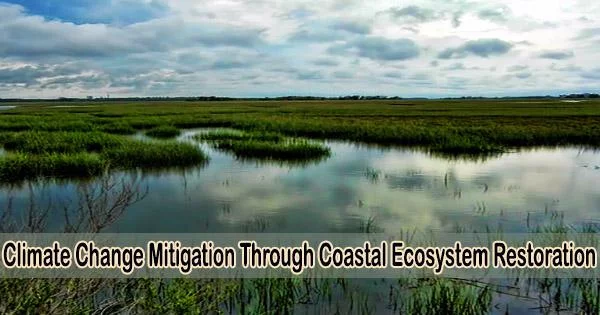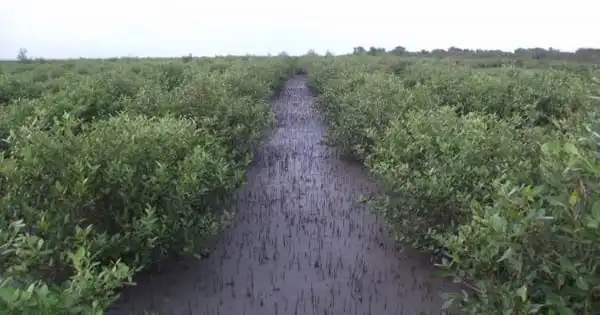Inadequate levels of greenhouse gases like carbon dioxide in the atmosphere are one of the main causes of climate change. Decarbonization, or electrifying the power grid or lowering the use of fossil fuels in transportation, and carbon dioxide removal, or removing already existing carbon dioxide from the atmosphere, are both necessary for mitigating climate change in the twenty-first century.
Researchers from Yale University and the Georgia Institute of Technology are putting forth a brand-new method for restoring coastal ecosystems so that they can permanently absorb carbon dioxide from the atmosphere. Blue carbon ecosystems, which include mangroves and seagrass, naturally absorb carbon through photosynthesis, which transforms carbon dioxide into living organisms.
“Mangroves and seagrasses extract carbon dioxide from the atmosphere all day long and turn it into biomass,” said Chris Reinhard, an associate professor in the School of Earth and Atmospheric Sciences (EAS). “Some of this biomass can get buried in sediments, and if it stays there, then you’ve basically just removed carbon dioxide from the atmosphere.”
The local flora and wildlife could possibly gain from the restoration of these ecosystems, and coastal economies could be stimulated. However, Reinhard and colleagues now propose that repairing them might also remove extra carbon through a brand-new method while battling rising ocean acidity.
In May, they presented their research in “Ocean Alkalinity Enhancement Through Restoration of Blue Carbon Ecosystems” in Nature Sustainability.
Carbon 101
The two main types of carbon that move back and forth inside the Earth’s system are organic and inorganic. Living things including algae, plants, animals, and even people contain organic carbon. This type of carbon can temporarily remove carbon dioxide from the atmosphere, but if it is buried in seafloor sediments, it can result in a permanent removal of carbon dioxide.
Mangroves and seagrasses extract carbon dioxide from the atmosphere all day long and turn it into biomass. Some of this biomass can get buried in sediments, and if it stays there, then you’ve basically just removed carbon dioxide from the atmosphere.
Professor Chris Reinhard
Although it can be found in many other forms, such as rocks and minerals, inorganic carbon is also a substantial dissolved component of ocean water. Since the industrial revolution, over 30% of the carbon produced by human activity has been preserved in the ocean as dissolved inorganic carbon.
The removal of carbon dioxide by inorganic carbon has the potential to be far more lasting, even though the organic carbon storage of carbon dioxide can be disrupted, effectively dispersing carbon dioxide back into the atmosphere.
“Even if you change the way a coastal ecosystem restoration project is operating, potentially remobilizing previously stored organic carbon, inorganic carbon capture is largely a one-way street,” said Mojtaba Fakhraee, lead author of the study and former postdoctoral researcher in EAS. “So even if a massive ecosystem disruption in the future undoes organic carbon storage, the inorganic carbon that has been captured will still be in the ocean permanently.”
Capturing Carbon, Counteracting Acidity
Natural carbon removal from the atmosphere and a variety of environmental and economic benefits are provided by coastal ecosystems to coastal populations. However, several human actions have significantly degraded or destroyed the natural coastal environments.
More mangroves and seagrasses can be planted, maintained, and protected, which will help the ecosystem operate again and remove more carbon from the atmosphere.
It’s not a novel concept to revitalize coastal ecosystems as a method of reducing carbon emissions, but prior research has concentrated on organic carbon burial and has not looked at the possibility of carbon removal through the creation of inorganic carbon.
Beyond climate change, ocean acidification, which is caused by atmospheric carbon dioxide dissolving in water and lowering the pH of the ocean, is another significant effect of human usage of fossil fuels. This acidity can have detrimental effects on a variety of creatures, including corals.
Because the chemical processes that result in carbon dioxide capture as inorganic carbon require alkalinizing ocean waters, storing carbon dioxide as inorganic carbon in the ocean may assist to counteract this.
“The basic idea here is that you are shifting the acid-base balance of the ocean to drive conversion of carbon dioxide in the atmosphere to inorganic carbon in the ocean,” Reinhard said. “This means that the process can help to partially offset the negative ecological consequences of ocean acidification.”
Modeling Carbon Capture
The researchers created a computer model to reflect the chemistry and physics of sedimentary systems, the complex mixture of solid particles, live organisms, and seawater that accumulates at the seafloor, in order to investigate how efficient restoring coastal ecosystems could be for inorganic carbon collection.
The model’s ability to track explicitly the advantages of restored mangrove or seagrass ecosystems and their effects on the cycling of both organic and inorganic carbon is a significant advancement. It also accounts for the effects of other greenhouse gases, including methane, which can occasionally be produced during the restoration of mangrove and seagrass ecosystems.
“This model comes up with representations for the rates of carbon transformation in the sediment based on how much mangrove is growing above the sediment,” said Noah Planavsky, senior author on the study and professor of Earth and planetary sciences at Yale. “We found that across an extremely large range of scenarios, restoration of blue carbon ecosystems leads to durable carbon dioxide removal as dissolved inorganic carbon.”
The research team expects that it will encourage the protection of existing coastal habitats and monetarily encourage the repair of deteriorated ecosystems, possibly serving as a novel type of carbon offset.
“Companies that are trying to offset their own emissions could potentially purchase carbon removal through funding restoration of coastal ecosystems,” Reinhard said. “This could help rebuild these ecosystems and all of the environmental benefits they provide, while leading to durable carbon dioxide removal from the atmosphere.”
















